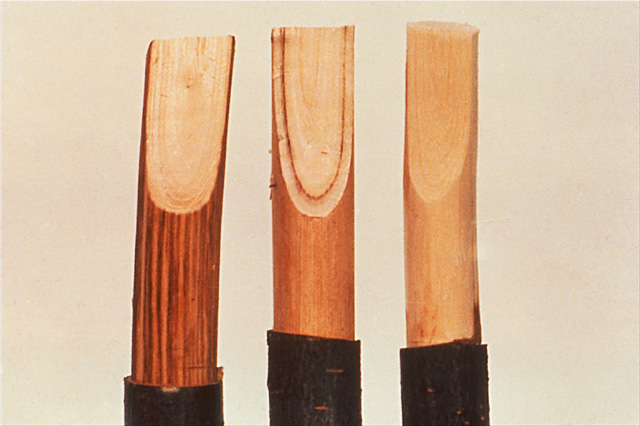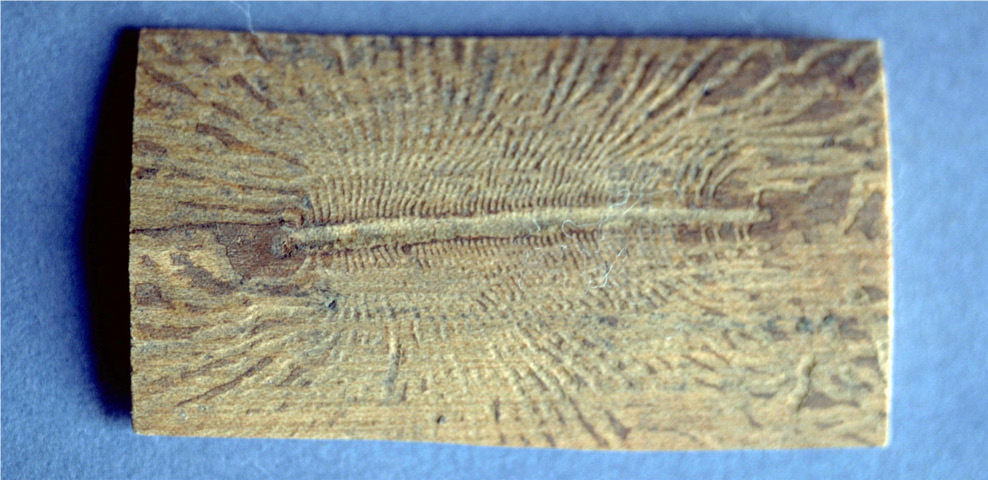Dutch elm disease is caused by two closely related fungi, Ophiostoma ulmi or O. novo-ulmi. The fungi are spread from tree to tree by elm bark beetles or via root grafts in adjacent trees. The disease was first described in Holland in 1920 (where the name originated) and was introduced to the eastern U.S. on diseased logs in the 1930’s. It was and still is one of the most destructive shade tree diseases in the U.S. today. All native elm species are susceptible, but Asian elm species are less susceptible.

Left - current springwood exhibiting streaking; Center - healthy summerwood
over infected springwood; Right – healthy uninfected wood. Credit: APS.
Description
The first symptom to appear is wilting or “flagging” of the leaves. The wilted leaves curl, turn yellow, then brown, and often drop prematurely. Flagging is usually seen in the spring or summer, and most commonly at the ends of branches. Dead branches may appear on only a portion of the tree. The tree may then die branch by branch over a period of several years. Sometimes an entire tree will develop disease symptoms and die within a few weeks. The process is more rapid on young or fast-growing trees.
When the bark of infected twigs and branches is peeled back, brown streaking or mottling is visible on the outer layer of wood. It is important to examine a cross-section of dead or dying branches. In a cross-section of a branch or twig, if the tree is infected during the current growing year, the browning appears as a broken or continuous ring in the outer rings of the wood. A ring of unstained wood may surround the browning if the tree was infected in previous years. If the bark is peeled back from dead branches or trees, tunneling of elm bark beetles can usually be seen. The symptoms of Dutch elm disease are sometimes confused with those due to drought stress or feeding by the elm leaf beetle; in these cases, however there is no discoloration in the sapwood and no tunneling. Two species of bark beetles carry the Dutch elm disease fungi, the European elm bark beetle (Scolytus multistriatus) and the native elm bark beetle (Hylurgopinus rufipes). They are stout, reddish-brown beetles, about 1/8” long. They feed on the twigs, often in the crotches, of healthy elm branches. The native elm bark beetle is most common in New England.
Disease Cycle
The European elm bark beetles overwinter as adults or larvae in their tunnels. The adults emerge in the spring and begin to feed. They can be found continuously from May to September. There may be 2-3 generations each year. Elm bark beetles are attracted to stressed, dying or dead elms to complete the breeding and egg-laying stages of their life cycle. Adult native elm bark beetles usually tunnel into the bark on the lower stems of healthy elms to overwinter, and then emerge in the spring to feed as described above.
The fungus overwinters in the wood of infected, dying trees and produces spores in the bark beetles’ tunnels, where the beetles may pick up the spores as they move through the tunnels and emerge from infected trees. The fungal spores are spread to healthy trees when the adult beetles emerge, fly to healthy trees and feed on the twigs. The native elm bark beetle may also introduce the fungus to healthy trees in the fall. Throughout the summer months, the fungus grows and spreads in the tree’s vascular system, causing the symptoms described above. Infections that occur through root grafts can spread very rapidly throughout the tree, as the fungus is carried upward in the sapstream.
Elms are most susceptible to infection after the first leaves unfurl through midsummer. Vigorously growing trees are generally more susceptible than slower growing trees. Trees are less susceptible under drought conditions (although symptoms usually advance more quickly during, and the year following drought).

USDA APHIS ITP, Bugwood.org

Credit: W. M. Brown Jr., Bugwood.org.
Management
IPM Strategies:
- Cultural Practices - Destroy dead elm material (logs, dead trees, etc.); if logs are stored, remove bark. This must be done before the adult beetles emerge in the spring.
Prune infected branches as soon as first symptoms are observed. All infected branches should be removed at a branch fork at least 5 feet, and preferably 10 feet, below the last sign of streaking in the sapwood. (This is effective only if 5% or less of the tree is showing flagging or wilting symptoms.)
Physically destroy root grafts between adjacent trees. Destroy root grafts before infected trees are removed.
Plant resistant cultivars (American elm: New Harmony, Princeton, Valley Forge, Prairie Expedition, St. Croix). (Resistant hybrid Asian elms: Accolade, Cathedral, Discovery, Triumph, Commendation, Denada Charm.)
- Chemical Control - Fungicide injection may be warranted for high value or historically important trees. Treatment must be done by a certified applicator. Consult your county Extension Educator or State Specialist for specific pesticide recommendations.

Stop! Read the label on every pesticide container each time before using the material. Pesticides must be applied only as directed on the label to be in compliance with the law. All pesticides listed in this publication are contingent upon continued registration. Contact the Division of Pesticide Control at (603) 271-3550 to check registration status. Dispose of empty containers safely, according to New Hampshire regulations.
Download the resource for the complete factsheet.

